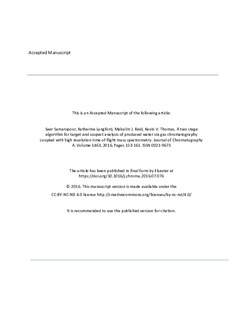A two stage algorithm for target and suspect analysis of produced water via gas chromatography coupled with high resolution time of flight mass spectrometry
Journal article, Peer reviewed
Accepted version
Permanent lenke
http://hdl.handle.net/11250/2560764Utgivelsesdato
2016Metadata
Vis full innførselSamlinger
- Publikasjoner fra Cristin - NIVA [2160]
- Scientific publications [1172]
Sammendrag
Gas chromatography coupled with high resolution time of flight mass spectrometry (GC-HR-TOFMS) has gained popularity for the target and suspect analysis of complex samples. However, confident detection of target/suspect analytes in complex samples, such as produced water, remains a challenging task. Here we report on the development and validation of a two stage algorithm for the confident target and suspect analysis of produced water extracts. We performed both target and suspect analysis for 48 standards, which were a mixture of 28 aliphatic hydrocarbons and 20 alkylated phenols, in 3 produced water extracts. The two stage algorithm produces a chemical standard database of spectra, in the first stage, which is used for target and suspect analysis during the second stage. The first stage is carried out through five steps via an algorithm here referred to as unique ion extractor (UIE). During the first step the m/z values in the spectrum of a standard that do not belong to that standard are removed in order to produce a clean spectrum and then during the last step the cleaned spectrum is calibrated. The Dot- roduct algorithm, during the second stage, uses the cleaned and calibrated spectra of the standards for both target and suspect analysis. We performed the target analysis of 48 standards in all 3 samples via conventional methods, in order to validate the two stage algorithm. The two stage algorithm was demonstrated to be more robust, reliable, and less sensitive to the signal-to-noise ratio (S/N), when compared to the conventional method. The Dot-product algorithm showed lower potential in producing false positives compared to the conventional methods, when dealing with complex samples. We also evaluated the effect of the mass accuracy on the performances of Dot-product algorithm. Our results indicated the crucial importance of HR-MS data and the mass accuracy for con dent suspect analysis in complex samples.

